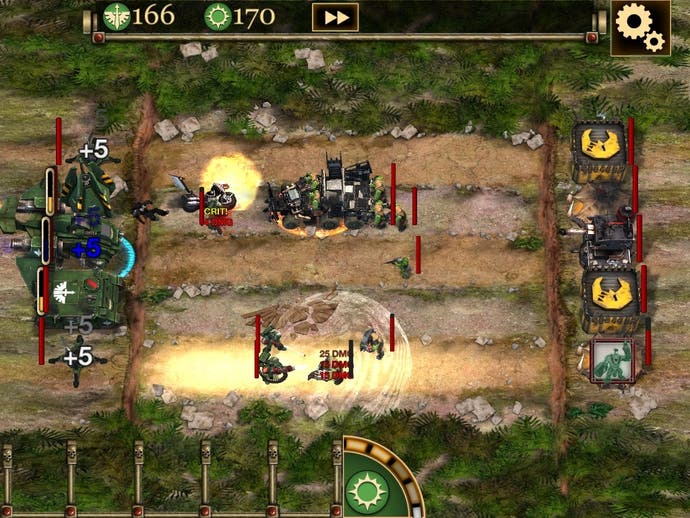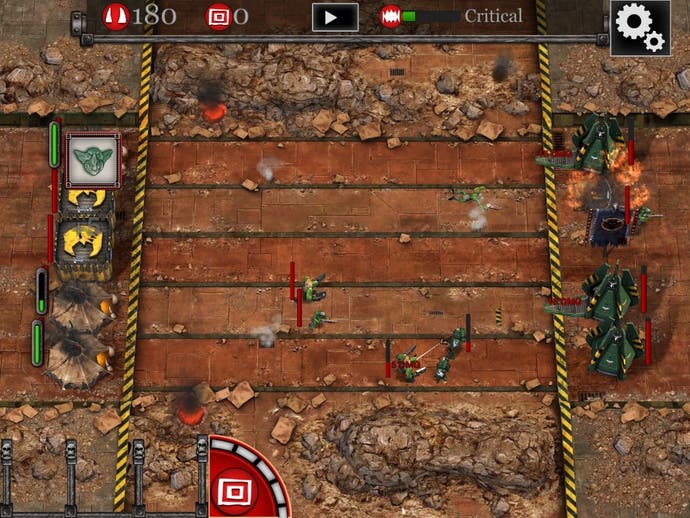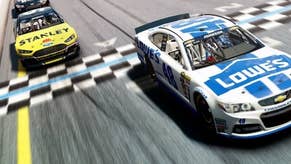Warhammer 40K: Storm of Vengeance review
Churn-based strategy.
"In the grim dark future there is only war." Warhammer 40K doesn't mess about when establishing the tone of its brutal, galaxy-spanning fantasy. "There is no peace amongst the stars, only an eternity of carnage and slaughter, and the laughter of thirsting gods."
These are the words, the mantra, that lure fans of Games Workshop's venerable tabletop game into its bloody embrace. It's a promise: an invitation to a hell of endless combat, religious zealotry and constant sacrifice where violence is the only constant, death is the greatest honour and the prose is always deliciously purple. It's heady stuff.
In the hands of developer Eutechnyx, once famous for its driving games, now infamous for Ride to Hell: Retribution, Warhammer's florid, ferocious vision has been boiled down to... queuing.
Storm of Vengeance is, apparently, a "lane strategy game" which is a fancy way of saying "a bit like Plants vs Zombies". Instead of plants you have the Space Marines of the Adeptus Astartes, and instead of zombies you have a rabble of greenskin Orks. To be even more precise, it takes its gameplay pretty much wholesale from Eutechnyx's own 2013 iOS game Ninja Cats vs Samurai Dogs, while its Warhammer credentials supposedly come from the 1997 Storm of Vengeance tabletop campaign. Fans are unlikely to recognise much beyond the name.

It's a game in which Space Marines and Orks line up and walk slowly past each other, occasionally stopping to lethargically trade shots. The battlefield is represented by five horizontal rows, with building plots at each end. You start at the left, your enemy is on the right and the aim is to get your units all the way across the screen, power through whatever building is in your way and claim that row for yourself. Take three rows and you win.
The building types available to you are limited. There's an energy-generating structure for each faction - the Space Marines cash in Redemption to create units, while Orks use Teef as their currency - as well as three different barracks-style buildings which spit out combat units. It's here the game comes close to having an idea it can call its own, as units are produced as "cards" which can be dragged and dropped onto any lane, regardless of which building generated them, or stored for later. Your guys march left to right, the enemy comes the other way, and battle is joined.
There's also a secondary resource to manage - Resolve for the humans, Psychic for the Orks. This is used to call in special attacks, to deliver status buffs and simplistic orders or to summon unique units. You can also use your XP to unlock more equipment slots for your troops, but since each addition lengthens their build time for only a small battlefield advantage, there's little incentive to experiment. Out of the two, it's the Orks who offer the most interesting array of units and abilities, but that leaves the game feeling awkwardly balanced, with the pivotal Space Marine faction being tedious to play and boring to battle against.
There's just no getting past the fact that Storm of Vengeance is crushingly dull - a game about watching construction bars fill up and health bars go down, over and over again. The presentation is drab, with campaign missions selected from a lifeless and empty map screen, while the in-game graphics are only a few steps away from being stick figures.

Animation is crude, but it's the fact that the backdrop almost never changes that really saps the life out of the thing. There's no sense of progression or scale, no suggestion that you're actually taking part in an epic military campaign. The prosaic story captions that bookend each mission may tell you that you're attacking a city or routing enemies from a harbour, but the battle itself always looks like the same tiny skirmish taking place in the same corner of a farmer's freshly ploughed field over and over. It's like Groundhog Day in power armour.
It's not as if the clashes between units do anything to put meat on the bones. At range they sputter away at each other with shots that sometimes do nothing and sometimes do damage, while up close they swish the air in front of them until somebody falls down. Units can be stunned if they receive too many hits in quick succession, but as with almost every detail that might help you develop deeper strategies, there's nothing to show when this has happened. Since your units progress in a walk-stop-shoot fashion already, it's hard to tell if a unit is stunned or just stopped for a break. Critical hit chances, damage-to-defence ratios - none of this data is available, despite being apparently used to decide the outcome of battles. Where unit stats are concerned, you're almost always playing blind.
Most maddening of all is the complete lack of AI that these basic figurines display. Units are able to attack adjacent lanes, but are still compelled to keep moving forwards, even if that means walking right past an enemy in a shuffling conga line that looks more like they're queuing at the supermarket checkout than engaging in ideological war. I'll repeat that for the Warhammer fans who may have just planted their faces on their desks: this is a game where Space Marines will blithely stroll right past Orks that are attacking their base, because they're not allowed to turn around or stand and fight.
Small and fussy, Storm of Vengeance crudely pastes Warhammer 40K branding on top of a thin and generic one-button framework

It's bizarre - a complete misunderstanding of Warhammer's ruthless do-or-die aesthetic. "Lane strategy" means little more than flinging as many units as you can muster down the lines, like so many ambivalent bowling balls, and winning through sheer force of numbers. That bog-standard approach is enough to see you through a good chunk of each campaign, until you hit a crude and artificial difficulty spike created by having your opponent suddenly churn out bigger and tougher units faster than you can. At that point, what shreds of enjoyment remain are blown away on the winds of frustration.
The deeper you dig into Storm of Vengeance's shallow soil, the more you realise how little reason there is to attempt anything more ambitious than crude spam-and-rush tactics. Right from the start, I focussed my attacks on the enemy buildings that generated their resources, reasoning that this would essentially cut off their ability to create new units. It didn't. The enemy kept spawning troops despite having no visible means of doing so. At that point, why even bother thinking about what you're doing?
Similar scruffy ideas are apparent everywhere. No matter which campaign you play first, you'll have to play through the lengthy, stodgy tutorial again - with only minor differences - when you switch sides. There's multiplayer, but it has no connection to the offline play so you have to start over, levelling up and unlocking the same units. There's so much waste, stodge and redundancy that simply trying everything in the game feels like a slog.
Small and fussy, Storm of Vengeance crudely pastes Warhammer 40K branding on top of a thin and generic one-button mobile game framework. What depth it does offer is limited in scope and too often obscured by game mechanics that become irritating or repetitive almost immediately. It's simply no fun to play, and yet is pitched at a niche fan audience that is already accustomed to more depth, more strategy, more gristle than this anaemic effort could ever manage. The Emperor expects more.











